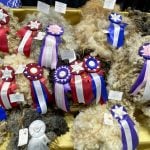REGINA – Bison are bouncing back, just not high.
Producers say the recovery reflects the reality of the market and appears to be relatively free of speculators.
“We don’t really want to see those prices from the late 1990s and pre-BSE again. They weren’t sustainable and the industry is still paying for the bust,” said Melfort, Sask., producer Bill Bintner.
He said the prices paid for bison when breeding stock pressures dominated sales created problems.
Numbers from the national bison show and sale at Canadian Western Agribition show a 20 percent increase over the same event last year.
Read Also

Beef cattle more prone to trace mineral deficiencies
The trace mineral status of our cows and calves is a significant challenge for western Canadian producers and veterinarians.
“The prices that were paid in Regina were about right for the most part. This is now a meat-driven industry and prices reflect that,” said Bintner.
Les Kroeger of Hanley, Sask., said the sale’s prices of about $550 for better quality yearling heifers reflect the market and the industry’s ability to pay.
“Producers, the ones that survived the past few years, are spending their money carefully. Most lived though the high prices of $10,000 bulls and $8,000 cows and they aren’t quick to part with money,” he said.
Bintner said producers that financially survived a 90 percent price drop are still unable to pay more for stock than they are now.
Yearling bulls at the Agribition sale weighing 1,000 to 1,500 pounds brought between $1,200 and $1,500.
“That’s a meat price. They were well finished animals that were entered in the show and next week they’ll be hanging on a hook,” he said. “Five or six years ago they would have been snapped up by speculators as bulls for three times that much.”
Bred two-year-olds at the sale brought $500 to $1,350 while yearling heifers went for $300 to $600.
The top selling bull was the show’s champion bred by XY Bison Ranch of Fort St. John, B.C. Bill and Fay Bouffioux reared the animal. They brought five animals from British Columbia for the national event and received several awards including breeder of the year.
“Prices are appropriate these days,” said Bill Bouffioux. “Maybe a little low yet, but the industry is still finding its feet. We are in the meat business and you see today a healthy industry that is keeping that in mind.”
In total, 45 animals sold at the Regina sale bringing $62,050, for an average of $1,378.
Gerald Parson of Stratford, Oklahoma, said his herd contains many Canadian bison and a reopening of the American border will likely improve Canadian prices substantially.
“We’re getting 50 percent or higher over what’s being paid in Canada right now for good stock. The industry is growing rapidly again in the U.S.,” he said.
“We’d like to get that border open and see some more good Canadian stock flowing south. That would help out the Canadian industry with an expanded market,” he said.
Bintner said American sales are bringing about double the Canadian price for high quality cows.
“Good bulls bring $3,500 to $5,000 in Colorado. I’d feel pretty lucky to get $3,500 for a bull these days,” he said.














